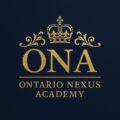Our Programs
Ontario Nexus Academy offers four core programs designed to serve students at every stage of their academic journey. Each program is built on the foundation of the Ontario Ministry of Education curriculum and delivered through a flexible online platform supported by certified teachers and dedicated counsellors.

1. OSSD Credit Program (Grades 9–12)
ONA’s flagship program leads directly to the Ontario Secondary School Diploma (OSSD), one of the most respected and widely recognized high school diplomas in the world. Students complete Ministry-approved credit courses via two pathways: Independent Study through SchoolConex Live Guided Learning with 4 live video classes per week led by OCT-certified teachers Each student is assigned a guidance counsellor who builds a custom study plan and assists with credit tracking and university applications.

2. Primary & Intermediate Program (KG–Grade 8)
This foundational program covers: English, Math, Science, Social Studies, French Health & Physical Education, Digital Literacy Designed to prepare students for high school success, with interactive lessons, quizzes, projects, and light parental support.

3. ESL Credit Courses (5 Levels)
From ESLAO to ESLEO, each ESL course earns one credit toward the OSSD. The program develops: Speaking, listening, reading, writing Grammar, pronunciation, vocabulary Cultural awareness Delivered with interactive content and evaluated using Ministry rubrics.

4. IELTS Preparation Courses
For students planning to take the IELTS Academic exam. Offered in three levels: Beginner, Intermediate, Advanced Includes live instruction, practice exams, writing support, and score tracking.
OSSD COURSES OFFERED
🟩 Grade 9 Courses (8 Courses)
ENL1W – English (De-streamed)
🕐 Instructional Time: 110 hours
📘 Prerequisite: None
This course develops foundational literacy and communication skills. Students explore a range of literary forms—short stories, poetry, graphic novels, and informational texts—and build oral and written communication through individual and collaborative work. They learn to organize thoughts clearly, edit with purpose, and express opinions supported by evidence.
🎯 Learning Expectations:
- Analyze themes and perspectives in diverse texts
- Write structured paragraphs, creative texts, and media responses
- Improve grammar, vocabulary, and sentence structure
- Communicate ideas through discussions and presentations
✅ Skills Developed: Writing fluency, reading comprehension, media analysis, public speaking
📊 Assessment: Personal narrative, visual media response, literary journal, oral presentation
🌍 Applications: Foundational communication for all academic and career pathways
🎓 Related Pathways: English, law, social science, education
MTH1W – Mathematics (De-streamed)
🕐 Instructional Time: 110 hours
📘 Prerequisite: None
This course introduces mathematical reasoning through algebra, number sense, geometry, measurement, probability, and data. Students engage in real-world problems using strategies such as proportional reasoning, graphing, and spatial visualization.
🎯 Learning Expectations:
- Represent relationships using algebra and functions
- Analyze geometric figures and their measurements
- Interpret and organize data sets and probabilities
- Apply math to financial and daily decision-making contexts
✅ Skills Developed: Equation solving, proportional reasoning, graph interpretation
📊 Assessment: Real-life application tasks, problem-solving journals, quizzes, unit projects
🌍 Applications: Everyday budgeting, logic, problem solving in all disciplines
🎓 Related Pathways: Business, STEM, trades, economics
SNC1W – Science (De-streamed)
🕐 Instructional Time: 110 hours
📘 Prerequisite: None
Students investigate topics in biology (ecosystems), chemistry (atomic structure), physics (energy and motion), and space science. Inquiry skills are emphasized through laboratory experiments and environmental exploration.
🎯 Learning Expectations:
- Investigate matter, energy, and life systems
- Analyze environmental interactions and sustainability
- Apply scientific methods to practical situations
- Interpret scientific data and communicate conclusions
✅ Skills Developed: Hypothesis testing, experimental design, observation, research skills
📊 Assessment: Lab reports, science journals, group investigations, summative tests
🌍 Applications: Environmental science, technology, healthcare foundations
🎓 Related Pathways: Biology, chemistry, engineering, life sciences
CGC1W – Geography of Canada
🕐 Instructional Time: 110 hours
📘 Prerequisite: None
This course explores Canada’s natural systems, human activity, and environmental challenges. Students learn to read maps, analyze data using GIS tools, and propose solutions to geographic problems such as climate change and urban development.
🎯 Learning Expectations:
- Investigate physical geography and population distribution
- Analyze economic activities and resource management
- Examine Canada’s global connections and roles
- Use geographic inquiry and digital tools to present findings
✅ Skills Developed: Map analysis, research synthesis, global awareness
📊 Assessment: Field study analysis, GIS-based mapping projects, reports, presentations
🌍 Applications: Sustainability planning, urban development, tourism
🎓 Related Pathways: Environmental studies, international development, policy studies
FSF1D – Core French, Academic
🕐 Instructional Time: 110 hours
📘 Prerequisite: Minimum of 600 hours of elementary Core French or equivalent
This course strengthens students’ ability to understand and communicate in French. Through dialogues, reading, media analysis, and cultural exploration, students expand vocabulary and grammar fluency.
🎯 Learning Expectations:
- Interpret and produce spoken and written French in familiar contexts
- Use past and present tenses correctly
- Demonstrate understanding of Francophone culture and traditions
- Communicate personal opinions and narratives in French
✅ Skills Developed: Oral interaction, reading strategies, basic writing mechanics
📊 Assessment: Oral interviews, listening tasks, cultural reflections, written assignments
🌍 Applications: Bilingual work environments, travel, global communication
🎓 Related Pathways: Languages, education, public service, translation
AVI1O – Visual Arts, Open
🕐 Instructional Time: 110 hours
📘 Prerequisite: None
Students explore elements and principles of design through various media including drawing, painting, sculpture, and digital tools. The course emphasizes creativity, technical skill, and interpretation of visual culture.
🎯 Learning Expectations:
- Apply the elements of design in original compositions
- Use creative and critical thinking in art production
- Reflect on the cultural and historical context of artworks
- Present and discuss personal artistic development
✅ Skills Developed: Visual communication, creativity, critical thinking
📊 Assessment: Sketchbooks, final projects, art critiques, reflective journals
🌍 Applications: Design, marketing, content creation
🎓 Related Pathways: Visual arts, architecture, advertising
PPL1O – Healthy Active Living Education
🕐 Instructional Time: 110 hours
📘 Prerequisite: None
Students develop movement skills, physical fitness, and health awareness. The course includes personal fitness plans, team sports, and health literacy on topics such as nutrition, stress, and mental wellness.
🎯 Learning Expectations:
- Participate in and reflect on various physical activities
- Demonstrate knowledge of healthy living practices
- Set and monitor personal wellness goals
- Demonstrate teamwork, sportsmanship, and leadership
✅ Skills Developed: Physical coordination, self-assessment, leadership
📊 Assessment: Fitness logs, skill performance evaluations, written reflections
🌍 Applications: Sports, personal health, wellness careers
🎓 Related Pathways: Kinesiology, health science, physical education
TAS1O – Exploring Technologies, Open
🕐 Instructional Time: 110 hours
📘 Prerequisite: None
This hands-on course introduces students to key concepts in design, engineering, and technological systems. Students explore problem-solving through digital and physical projects involving coding, construction, and 3D modeling.
🎯 Learning Expectations:
- Apply the design process to solve practical challenges
- Use tools and technology safely and effectively
- Build basic prototypes using different materials and software
- Analyze and improve design efficiency
✅ Skills Developed: Coding, mechanical reasoning, teamwork, planning
📊 Assessment: Engineering challenges, design journals, presentations, prototyping tasks
🌍 Applications: Robotics, architecture, manufacturing
🎓 Related Pathways: Engineering, tech education, design & construction

🟨 Grade 10 Courses (8 Courses)
ENG2D – English, Academic


This course builds on the foundations of Grade 9 English and emphasizes analytical reading, coherent writing, and critical thinking. Students study novels, plays (including Shakespeare), non-fiction, and media texts. Writing assignments focus on developing persuasive, comparative, and expository forms using evidence and clear structure.

- Analyze literary devices and author intent
- Write formal essays, comparative paragraphs, and opinion pieces
- Develop vocabulary, grammar, and editing skills
- Evaluate media messages and cultural perspectives




MPM2D – Principles of Mathematics, Academic


This course introduces key mathematical concepts such as algebraic expressions, quadratic equations, linear systems, and trigonometric ratios. Students explore relationships and functions and apply their learning to problem-solving and real-world situations.

- Model linear and quadratic relations using graphs and equations
- Solve systems of equations algebraically and graphically
- Use trigonometric ratios to solve triangle problems
- Analyze relationships and interpret mathematical models




SNC2D – Science, Academic


This course deepens understanding of scientific concepts in biology (genetics), chemistry (reactions), physics (optics), and earth science (climate systems). Students conduct laboratory experiments, interpret data, and examine the social impact of scientific advances.

- Conduct controlled investigations with scientific rigor
- Analyze patterns of heredity and chemical reactions
- Apply physics concepts to light behavior and lens use
- Understand climate change and environmental responsibility




CHC2D – Canadian History Since World War I, Academic


This course examines the political, social, and economic development of Canada from WWI to the present. Students explore Indigenous histories, civil rights movements, immigration, and Canada’s role in global conflicts and diplomacy.

- Analyze historical causes and consequences
- Interpret primary and secondary sources
- Evaluate continuity and change in Canadian identity
- Express historical arguments through various media




FSF2D – Core French, Academic


This course emphasizes fluency in reading, writing, listening, and speaking in French. Students explore Francophone cultures and respond to increasingly complex texts and situations, both orally and in writing.

- Interpret and analyze written and spoken French texts
- Compose structured written pieces in different styles
- Participate in discussions using accurate grammar
- Understand and reflect on Francophone diversity




AVI2O – Visual Arts, Open


This course allows students to refine their creative skills and explore new forms of artistic expression, including mixed media, digital art, and thematic installations. Students also analyze historical art movements and contemporary visual culture.

- Apply critical analysis to visual expression
- Plan and produce art using a creative process
- Reflect on personal growth and societal messages in art
- Explore cultural perspectives through visual media




GLC2O – Career Studies (0.5 credit)


This half-credit course introduces students to career exploration, self-discovery, and future planning. Students assess their skills, research career pathways, and develop plans for life after secondary school.

- Identify personal values, strengths, and interests
- Explore career clusters and post-secondary options
- Understand workplace expectations and labor market trends
- Build a personal résumé and career action plan




CHV2O – Civics and Citizenship (0.5 credit)


This course explores citizenship, democracy, and civic responsibility in Canada. Students examine social issues, government structures, and advocacy methods to become informed and active participants in society.

- Understand rights and responsibilities of Canadian citizens
- Analyze civic issues and propose solutions
- Engage in decision-making processes and policy debates
- Create action plans for civic participation





🟥 Grade 11 Courses (7 Courses)
ENG3U – English, Grade 11 (University Preparation)
🕐 Instructional Time: 110 hours
📘 Prerequisite: ENG2D, Grade 10 English
This course develops students’ critical literacy, communication, and academic writing skills. Students analyze a range of literary texts from different periods, cultures, and genres—including Shakespearean drama, modern novels, and persuasive non-fiction. Through essay writing, presentations, and comparative analysis, students learn to construct and support sophisticated arguments.
🎯 Learning Expectations:
- Analyze literary themes, forms, and stylistic techniques
- Develop academic essays using logical structure and MLA citation
- Interpret author intent and rhetorical strategies
- Communicate ideas clearly through writing and oral presentations
✅ Skills Developed: Literary analysis, essay construction, grammar, argumentation, presentation
📊 Assessment: Literary essays, reading comprehension tests, seminar discussions, text comparisons
🌍 Applications: Academic writing, debate, critical reading
🎓 Related Pathways: Humanities, Law, Education, Journalism
MCR3U – Functions, Grade 11 (University Preparation)
🕐 Instructional Time: 110 hours
📘 Prerequisite: MPM2D, Grade 10 Academic Math
This course introduces students to the properties and applications of linear, quadratic, exponential, and trigonometric functions. Students learn algebraic techniques, function transformations, and modeling of real-life situations.
🎯 Learning Expectations:
- Represent functions algebraically and graphically
- Solve equations and inequalities
- Apply trigonometric ratios and identities
- Analyze rates of change and modeling scenarios
✅ Skills Developed: Algebraic reasoning, graphing, trigonometry, mathematical modeling
📊 Assessment: Problem sets, quizzes, function investigations, real-world math projects
🌍 Applications: Engineering, computer science, economics, data analysis
🎓 Related Pathways: Calculus, Physics, STEM programs
SBI3U – Biology, Grade 11 (University Preparation)
🕐 Instructional Time: 110 hours
📘 Prerequisite: SNC2D, Grade 10 Academic Science
This course focuses on cellular biology, genetics, biodiversity, human systems, and environmental interactions. Students explore these concepts through lab work, dissections, and independent research.
🎯 Learning Expectations:
- Investigate biological systems using scientific methods
- Analyze genetic processes and biodiversity trends
- Apply understanding of human anatomy and physiology
- Assess environmental impacts on ecosystems
✅ Skills Developed: Scientific investigation, microscopy, research analysis
📊 Assessment: Lab reports, case studies, presentations, unit tests
🌍 Applications: Health care, biotechnology, veterinary sciences
🎓 Related Pathways: Medicine, Environmental Science, Life Sciences
SCH3U – Chemistry, Grade 11 (University Preparation)
🕐 Instructional Time: 110 hours
📘 Prerequisite: SNC2D, Grade 10 Academic Science
This course introduces chemical bonding, reactions, stoichiometry, periodicity, and solutions. Students conduct hands-on experiments and apply theoretical knowledge to real-world contexts.
🎯 Learning Expectations:
- Predict and balance chemical reactions
- Investigate properties of elements and compounds
- Perform quantitative and qualitative analysis
- Understand the role of chemistry in society
✅ Skills Developed: Lab safety, formula calculations, molecular structure analysis
📊 Assessment: Titration labs, reaction modeling, quizzes, reports
🌍 Applications: Pharmacy, environmental testing, materials science
🎓 Related Pathways: Biochemistry, Chemical Engineering, Health Sciences
SPH3U – Physics, Grade 11 (University Preparation)
🕐 Instructional Time: 110 hours
📘 Prerequisite: SNC2D, Grade 10 Academic Science
This course covers motion, forces, energy, sound, and electric circuits. Emphasis is placed on experimentation, measurement, and the use of mathematical models to describe physical systems.
🎯 Learning Expectations:
- Analyze kinematics and dynamics in real-world contexts
- Apply laws of motion and conservation of energy
- Investigate wave phenomena and electrical principles
- Solve physics problems using vectors and equations
✅ Skills Developed: Measurement, problem solving, data interpretation
📊 Assessment: Experimental design tasks, lab reports, motion simulations
🌍 Applications: Engineering, aviation, audio technology, robotics
🎓 Related Pathways: Mechanical/Electrical Engineering, Astronomy, Computer Science
ICS3U – Introduction to Computer Science, Grade 11 (University Preparation)
🕐 Instructional Time: 110 hours
📘 Prerequisite: None
This course introduces students to structured programming using languages like Python or Java. Topics include algorithm development, control structures, modular design, and software ethics.
🎯 Learning Expectations:
- Write, test, and debug programs
- Use structured programming principles and logic
- Analyze problems and develop algorithmic solutions
- Understand digital ethics and cybersecurity
✅ Skills Developed: Programming, logical thinking, problem decomposition
📊 Assessment: Coding projects, algorithm flowcharts, code reviews
🌍 Applications: Software development, AI, app design, automation
🎓 Related Pathways: Computer Science, Software Engineering, Information Systems
AVI3M – Visual Arts, Grade 11 (University/College Preparation)
🕐 Instructional Time: 110 hours
📘 Prerequisite: AVI1O or AVI2O
This course enables students to further develop their knowledge and skills in visual arts. Using the creative process, students explore themes such as identity, social justice, and nature through drawing, painting, sculpting, and multimedia works. Emphasis is placed on critical analysis, portfolio development, and personal artistic voice.
🎯 Learning Expectations:
- Apply design principles to diverse media
- Critically interpret and reflect on historical and contemporary art
- Use digital and traditional tools for self-expression
- Curate a personal art portfolio
✅ Skills Developed: Concept development, visual storytelling, mixed media exploration
📊 Assessment: Portfolio submissions, artist statements, critique participation
🌍 Applications: Visual design, architecture, fashion, media arts
🎓 Related Pathways: Art & Design, Animation, Advertising, Architecture

🟥 Grade 12 Courses (7 Courses)
ENG4U – English, Grade 12 (University Preparation)
🕐 Instructional Time: 110 hours
📘 Prerequisite: ENG3U, Grade 11 English
This course prepares students for university-level studies in English by refining their ability to analyze complex texts, synthesize ideas, and communicate arguments effectively. Students engage with contemporary and classical literature, including novels, plays, poetry, and literary criticism. Emphasis is placed on independent research, essay writing, and oral communication in academic contexts.
🎯 Learning Expectations:
- Analyze themes, style, and context in advanced literary works
- Develop and defend critical arguments in written and oral formats
- Conduct independent research using academic sources
- Apply MLA formatting and proper citation techniques
✅ Skills Developed: Critical reading, advanced writing, research methods, public speaking
📊 Assessment: Literary essays, comparative analysis, seminars, research projects
🌍 Applications: Academic research, publishing, law, education
🎓 Related Pathways: Humanities, Communications, Journalism, Social Sciences
MHF4U – Advanced Functions, Grade 12 (University Preparation)
🕐 Instructional Time: 110 hours
📘 Prerequisite: MCR3U, Grade 11 Functions
This course deepens students’ understanding of polynomial, exponential, logarithmic, and trigonometric functions. Students explore transformations, inverses, and complex algebraic reasoning as preparation for calculus and post-secondary STEM programs.
🎯 Learning Expectations:
- Analyze key features of various functions
- Solve equations and inequalities involving multiple function types
- Explore mathematical modeling and transformations
- Apply functions to real-world applications
✅ Skills Developed: Abstract reasoning, graphing fluency, algebraic precision
📊 Assessment: Function investigations, problem sets, cumulative tasks, unit tests
🌍 Applications: Engineering, Economics, Data Analysis
🎓 Related Pathways: Calculus, Physics, Business, Computer Science
MCV4U – Calculus and Vectors, Grade 12 (University Preparation)
🕐 Instructional Time: 110 hours
📘 Prerequisite: MHF4U (taken concurrently or previously)
Students learn the principles of differential calculus, rates of change, vector operations, and their applications to real-world and theoretical problems. This course builds foundational skills for university-level mathematics.
🎯 Learning Expectations:
- Apply derivatives to solve problems involving rates and optimization
- Analyze functions for concavity, limits, and continuity
- Perform vector operations in 2D and 3D space
- Solve geometric and physical problems using calculus and vectors
✅ Skills Developed: Calculus operations, spatial reasoning, critical problem solving
📊 Assessment: Derivative applications, vector problem sets, final summative tasks
🌍 Applications: Engineering, Physics, Computer Graphics
🎓 Related Pathways: Engineering, Mathematics, Computer Science
MDM4U – Data Management, Grade 12 (University Preparation)
🕐 Instructional Time: 110 hours
📘 Prerequisite: MCR3U or MCF3M
Students study probability, statistics, and data modeling. Emphasis is placed on organizing and interpreting data using graphs, statistical software, and simulations.
🎯 Learning Expectations:
- Collect, organize, and interpret large data sets
- Understand probability theory and expected value
- Design experiments and evaluate bias
- Use data to support conclusions and decision-making
✅ Skills Developed: Statistical analysis, data visualization, logical reasoning
📊 Assessment: Data projects, surveys, cumulative investigations, written reports
🌍 Applications: Business analytics, Health research, Marketing
🎓 Related Pathways: Business, Psychology, Social Sciences
SBI4U – Biology, Grade 12 (University Preparation)
🕐 Instructional Time: 110 hours
📘 Prerequisite: SBI3U
This course explores molecular genetics, homeostasis, evolution, metabolic processes, and population dynamics. Students conduct in-depth lab work and apply inquiry-based scientific thinking to real biological systems.
🎯 Learning Expectations:
- Investigate biochemical processes and cellular functions
- Explore DNA technologies and genetic research
- Understand physiological systems and feedback mechanisms
- Analyze ecological data and evolutionary patterns
✅ Skills Developed: Lab accuracy, data interpretation, bioethics analysis
📊 Assessment: Molecular simulations, lab reports, inquiry portfolios
🌍 Applications: Medicine, Biotechnology, Environmental Sciences
🎓 Related Pathways: Health Sciences, Genetics, Ecology
SCH4U – Chemistry, Grade 12 (University Preparation)
🕐 Instructional Time: 110 hours
📘 Prerequisite: SCH3U
Students investigate advanced topics including organic chemistry, chemical equilibrium, thermochemistry, and electrochemistry. The course emphasizes problem-solving and laboratory technique.
🎯 Learning Expectations:
- Analyze equilibrium systems and pH calculations
- Conduct titrations and redox reactions
- Explore organic reactions and molecular structure
- Interpret thermodynamic and electrochemical principles
✅ Skills Developed: Chemical analysis, lab precision, quantitative problem solving
📊 Assessment: Formal lab reports, chemical modeling tasks, concept-based tests
🌍 Applications: Pharmacy, Environmental Engineering, Forensics
🎓 Related Pathways: Biochemistry, Chemical Engineering, Medicine
BOH4M – Business Leadership, Grade 12 (University/College Preparation)
🕐 Instructional Time: 110 hours
📘 Prerequisite: None
This course explores the principles of management, leadership styles, organizational behavior, and ethics in the workplace. Students plan and evaluate business projects, participate in leadership simulations, and analyze real-life case studies.
🎯 Learning Expectations:
- Apply management strategies to team-building and productivity
- Analyze business ethics, globalization, and workplace diversity
- Develop personal leadership skills and assess professional strengths
- Design and evaluate business initiatives
✅ Skills Developed: Communication, teamwork, decision-making, project planning
📊 Assessment: Group presentations, leadership reflections, business simulations
🌍 Applications: Entrepreneurship, Corporate Leadership, HR
🎓 Related Pathways: Business Administration, Commerce, Marketing
🟪 OLC4O – Ontario Secondary School Literacy Course (Grade 12, Open Level)
🕐 Instructional Time: 110 hours
📘 Prerequisite: Students who have been eligible to write the OSSLT (Ontario Secondary School Literacy Test) at least once and have not yet met the literacy requirement.
This course is designed to help students acquire and demonstrate the cross-curricular literacy skills essential for success in both secondary school and post-secondary life. OLC4O satisfies the Ontario Secondary School Diploma (OSSD) literacy requirement and provides direct instruction in reading and writing strategies.
Students read a range of informational and narrative texts and produce pieces such as news reports, summaries, opinion paragraphs, instructions, and essays. The course places special emphasis on organizing ideas, editing for clarity, and refining writing through peer and teacher feedback.
🎯 Learning Expectations:
- Demonstrate comprehension of informational and narrative texts
- Develop clear, structured writing using appropriate tone and format
- Use planning and editing strategies to improve writing effectiveness
- Apply reading and writing skills across subject areas and real-life situations
✅ Skills Developed: Reading for meaning, summarizing, structured writing, grammar accuracy
📊 Assessment: Written portfolios, reading comprehension tasks, timed writing exercises, peer reviews
🌍 Applications: Workplace communication, college/university readiness, digital literacy
🎓 Related Pathways: Required for graduation; enhances performance in all post-secondary programs

